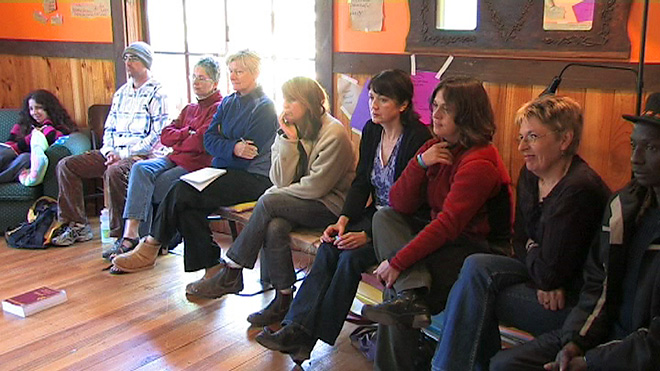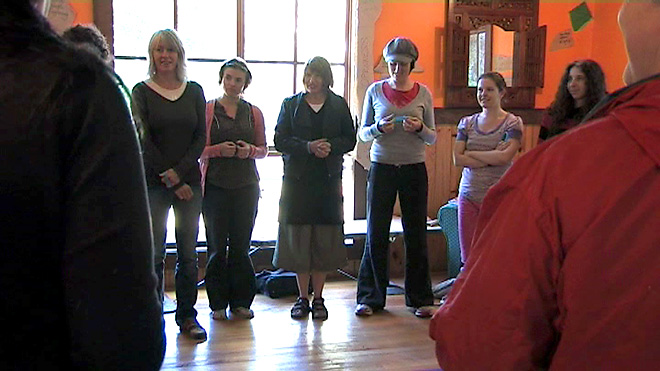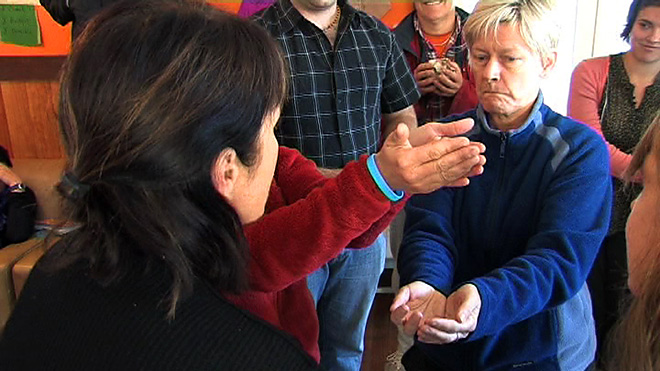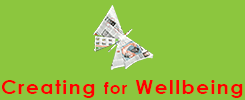Sensitive Mental Health Issues
When working within a mental health promotion framework, it is important that artists have an understanding of how to work with the sensitive mental health issues that students may be facing themselves or which may affect their families and friends. This presentation by Child and Adolescent Mental Health Promotion Officer Bernie Weckmann provides an engaging, interactive and informative introduction to some of these issues.
Dealing with Sensitive Mental Health Issues
I’ve worked for 25 years in child mental health, but mainly in a clinical role: really our responsibility at CAMHS is the treatment of mental illness, and I am actually the only health promotion position. Sometimes it is hard to define what that means because my colleagues are coming from working with children with problems. I see that I can bring a perspective that is bi-focular (clinical–scientific), and another way of looking at the things that artists offer.
The other thing I’m hoping to explore and clarify further here is the artist’s role – what artists can bring, what artists feel they still need to know, and some ideas and thoughts on how we can all work in partnership: teachers, mental health professionals and, most of all, young people.
Earlier today we had an interesting discussion about the tensions around funding, and how we often feel that we come from different mindsets to the funder, recognising that we have to jump through hoops to get funding or need to provide an evidence base to get results. We were talking also about that word “partnerships” – between arts and health – and I was thinking about the word “alliance” – you add a “d” and it’s dalliance! This brings more of a sense of fun to the relationship – but I am not wanting to suggest it’s temporary!

Activity One: What’s in a Label?
An activity exploring how labels can affect experience and perception.
- Spend some time doing a brainstorm of mental illness terms
- Review and read the poem by Sandy Jeffs, “People must think I am crazy,” in Poems from the Madhouse.
Bernie divided people into pairs and distributed a wristband to each person. On each wristband was written a label—the labels are illnesses from the DSM V1 manual. He asks each person to please undo their label and read what illness they have been labelled with.
Bernie says: “This isn’t a test of people’s knowledge of mental illness so be prepared to have a go.”
Participants are asked to think about their label for a moment, then they have two choices. They can either:
- Act out the label and have others try to guess what it is, or
- Come up with six words that they associate with this label.
This results in some fairly extraordinary performances and at times a confounded response from the rest of the group – especially when the “normal” label is being acted out!
Completion of the activity involves brief discussion about the impact of labels on young people, preconceptions held about the label, and issues of stigma related to labels. Also, Bernie asks participants to consider also how labels could be useful, why they are used, and how they can become damaging or unhelpful.

The concept of labels interests me, and I think people are not always clear about labels, although you can check the criteria. But labels mean more than just definition, because it is about how people respond to the labels. My opinion about labels changed when I developed severe depression, because it shifted from me from being a clinician to being a patient and having to start all over again. My partner went through the whole thing as well and I had to care for her. As an adult, I felt so affected, and I wondered about young people dealing with that. And it got me thinking about the labels that are useful and those that aren’t. Most of the slang that young people use around mental illness is not constructive. All the labels are jumbled together and are negative. If you have a physical disability, people tend to be solicitous, whilst depression makes people want to avoid a person. This is often based on fear, and it is these attitudes that are hard to deal with.
Artist 1: Mental health problems can be really frightening because people can be almost unrecognisable. Anne Deveson talked about her son who developed psychosis and was almost unrecognisable. Even depression is often manifested as anger, which is very difficult to handle.
Bernie: For me the key thing is that labels are sometimes useful and sometimes are not helpful. Understanding mental illness is really useful. But ultimately, labels belong on jars, not people. It is useful to identify illness in terms of appropriate response and classification, but it should not alter our attitude to a person.
Artist 1: It seems more helpful to say “a mental health issue” rather than give a label.
Bernie: Some young people want a label so that they can understand and process what’s going on. For young people, though, some labels are stickier than others. It’s how we use the labels and what we attribute to those labels.
Artist 2: As a parent and a teacher, without that label you sometimes don’t get support that enables you to access appropriate support.
Bernie: Yes, you need it to access resources, but it is how the label is used. There are fact sheets and plenty of resources in regards to this. But for me a label is only part of what a person is. It’s saying okay, someone has that label, but let’s see how they go. I want people to go beyond narrow stuff; that’s where the therapeutic part is – kids can go beyond what is anticipated.
Artist 3: There are other labels where kids may be labelled a troublemaker who will never be any good, and often they are often the kids you like the best: you may face differences between yourself and the teacher in a classroom about their behaviour.
Artist 5: The artists in our project are at the preparatory stage and have not met the kids we will be working with. There are two schools talking about a number of kids with labels, and they are telling us that they will point out who they are; but this also helps us because we can understand their behaviour and find ways to engage them. So a label is both problematic and useful. So much of being an artist is about taking problems and re-framing them.
Bernie: In my environment we focus on what’s going wrong, whereas with artists it may be useful to know problems and choose to either ignore them or to respond. It’s important to ask: “How much history do I need to work safely with these kids, and how much will this colour my attitudes?” It’s good also to know their strengths and abilities. Art does that better than we can.
Artist 6: Working with a mental health agenda is more difficult because you have a desired outcome, and are more limited in how far you can go. Artists can embrace kids, whilst officers can’t. I can see the reasons for this but when it takes away humanity … that is where the artist’s role is really important.
Bernie: It depends on environment, what you can do.
Artist 1: It’s still difficult in school to have hugging.
Artist 6: The reason I am alive today is thanks to the people around me who showed me love. So I believe when you have the opportunity to give young people love, they are going to take that with them for the rest of their life. It is important for your own mental wellbeing.
Artist 7: Your job as an artist is to go beyond the boundaries of any labelling if you are going to deliver your art to others or bring out the artist in them.
Bernie: Labels are very powerful and I worry about the value of them, and whilst they are helpful at other times they can be very stigmatising for young people, and I worry about their future prospects; for example, if at a job interview they are asked if they have a history and answer honestly. How do you define what is “normal” and is that the same as “acceptable”? What is our reference point, and how wide are the margins?
It’s particularly interesting when you are working with mixed ages: what is normal for different ages and across cultures? There are different expectations around this. A school’s definition is often what is acceptable in the classroom, whilst for an artist it is a little broader.

Activity Two: Young People Today – Where Might They Be “Coming From”?
The activity explores what normal behaviour may be for a young person? Is it the same as “acceptable” behaviour? Do we need to know all about different developmental stages and what’s normal for each stage? What is our reference point for “normal” behaviour and how wide are the margins? This is of particular interest when we are working with mixed groups of primary and secondary students.
Ask the question: “Based on your experience, what are some of the mental health-related issues that you might need to be aware of or respond to in working with young people? Some examples might include:
- Families where the parent has a mental illness, or where there is violence, abuse, alcohol or drug issues;
- Depression, deliberate self-harm, and suicidal risk;
- Protective concerns in younger children – abuse or neglect issues;
- Sexual abuse issues;
- Bullying and harassment issues.
What do we do if we recognise some of these factors are present in a young person’s life and pose a potential risk to their mental health and wellbeing?
What are our fears/anxieties about being able to deal with these issues?
The role of the artist in the Festival for Healthy Living (FHL) is not necessarily to be aware of all these individual issues; rather, it is to be aware that they may be present within the young person’s environment. We need to recognise when and how to access additional support or resources for a young person at risk. The role of the artist is generally recognised as a health-promoting and therapeutic one; however the artist is not primarily a therapist/clinician. Knowing what resources are available in your school or other contexts is an important part of ensuring safety and sharing the task of meeting the young person’s needs.
It is important also to understand the interplay between group and individual needs. Even if a young person discloses important issues around mental health and wellbeing it may not be particularly helpful for the artist to become pre-occupied with these individual needs. Indeed, it may be to the detriment of the rest of the group if too great a focus is taken on one individual. The challenge is to balance the collective needs of the class/group while also responding to specific needs of individual young people. This does not mean ignoring their needs, but rather ensuring that they are linked to other resources where needed.
The FHL is a universal approach that does not necessarily seek to elicit personal stories and information. While encouraging self-expression and openness, we can also be mindful of the potential harm of young people’s over-disclosure of personal issues. There are times when it may be appropriate to contain this and provide the young person with opportunity to deal with these issues in are more private and appropriate setting. Again, this may involve the use of other people/resources including teachers and health professionals.
It’s important for the artist to be aware of their role within the school. The artist as “outsider”/visitor often brings a more playful and creative perspective. This will often encourage engagement and increased openness with young people that may not be present in other relationships with adults. The “newness” and different approach of the artist can encourage young people to disclose information they may not have shared with others previously.
While this presents opportunities to meet the previously unrecognised needs of the young person, it also creates an environment in which an artist needs to be aware of boundaries and the potential need to draw on other professional advice/supports. Artists need to recognize both the link and the difference between self-expression and disclosure. Also, to recognize what disclosure is and how to respond.
For more on dealing with disclosure see the FHL’s Guidelines for Professional Learning.

Activity Three: Romeo and Juliet
How could artists use artistic and creative expression sensitively and appropriately so that young people don’t just disclose issues, but are then also able to be supported in exploring them and reaching positive solutions?
Romeo and Juliet provides an example: often when the play Romeo and Juliet is watched or “done” in schools the issue of suicide becomes part of the discussion. Rather than steer away from a discussion like this we need to guide it so that young people can explore the issue safely.
For example: why do you think they suicided? Was this their only option? What other ways could they have dealt with the situation? Who is responsible? Were they thinking straight? Was there a mental health issue? And so on.
Bernie: There are mental health officers in each region and I would encourage people to use them and to engage with them. I am not an expert on everything but I know where to get information.
Artist 10: I think it s really valuable for people to get an understanding of mental health issues, but also to acknowledge that you are working in a community, and each community can be subtly different. For example, there are two special development schools that we worked with and they were very contrasting in their approaches. And whilst we can get information, we are still working in a different community and the information may not match up with the way school works. You need to understand the context; it’s not enough just to know about the condition.
Artist 14: Yes we are doing good work, but it is how. You have to accept who they are before you work with them.
Bernie: Relationship is the key…
